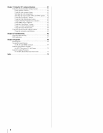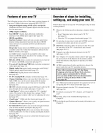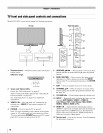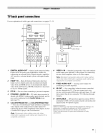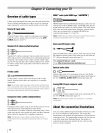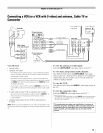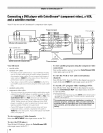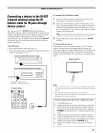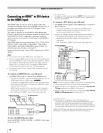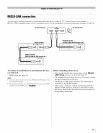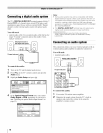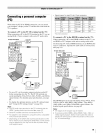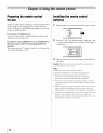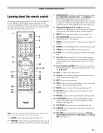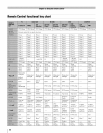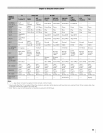
inganHDM 0rDvi device
to the HDMIinput
The HDMI input on your TV receives digital audio and
uncompressed digital video from an HDMI source device, or
uncompressed digital video from a DVI (Digital Visual
Interface) source device.
This input is designed to accept HDCP (High-Bandwidth
Digital-Content Protection) program material in digital form
from EIA/CEA-861 -D-compliantI_ Iconsumer electronic
devices (such as a set-top box or DVD player with HDMI or
DVI output).
The HDMI input can accept and display VGA, SVGA, XGA,
WXGA, SXGA, 480i (60Hz), 480p (60Hz), 72% (60Hz),
1080i (60Hz), and 1080p (24Hz/60Hz) signal formats. For
detailed signal specifications, see page 69.
Supported Audio format: Linear PCM, sampling rate 32/44.1/
48 kHz
Note:
• To connect a PC to the HDMI input, see page 19.
• Some of legacy HDMI sources may not work properly with
your latest HDMI TV,due to new standard adoption. Please
try setting the following three options (Lip-Sync Latency,
Deep Color, x. v.Color) to Off. Your legacy HDMI source
should operate properly with your TV. See page 69.
• Supported Audio format : Linear PCM, sampfing rate 32/
44.1/48kHz
To connect an HDMI device, you will need:
• one HDMI cable (type A connector) per HDMI device
- For proper operation, it is recommended that you use an
HDMI cable with the HDMI Logo (H.-trnl ).
- To display an 1080p/6OHz signal format, you will need a
High Speed HDMI cable. Conventional HDMI/DVI cable
may not work properly.
- HDMI cable transfers both video and audio. Separate
analog audio cables are not required (see illustration).
- See "Setting the HDMI TMaudio mode" (=r_,,page 39).
TVupperbackpanel TVrightsidepanel
I
"DML2vice.....
_@)................. i _,= _.......
To view the HDMI device video:
Select the HDMI 1, HDMI 2, HDMI 3, or HDMI 4 video input
source on the TV.*
* To select the video input source, press INPUT on the remote control
(r_ page 21 ). To program the TV remote control to operate other
devices, see Chapter 3.
To connect a DVI device, you will need:
• one HDMI-to-DVI adapter cable (HDMI type A connector)
per DVI device
- For proper operation, the length of an HDMI-to-DV/
adapter cable should not exceed 9.8 ft (3m). The
recommended length is 6.6 ft (2m).
• one pair of standard analog audio cables per DVI device
- An HDMI-to-DVI adapter cable transfers video only.
Separate analog audio cables are required (see
illustration).
- See "Setting the HDMf _ audio mode" (_," page 39).
TVupperbackpanel
IN IN _ IN
'®,¢
.... I I
DVI dev!ce .... ZF ======__
® ®--
Note: To ensure that the HDMI or DVI device is reset properly,
it is recommended that you follow these procedures:
• When turning on your electronic components, turn on the
TV first, and then the HDMI or DVI device.
• When turning off your electronic components, turn off the
HDMI or DVI device first, and then the TV.
[1] EIA/CEA-861-D compliance covers the transmission of
uncompressed digital video with high-bandwidth digital content
protection, which is being standardized for reception of high-
definition video signals. Because this is an evolving technology, it
is possible that some devices may not operate properly with the TV.
HDMI, the HDMI logo and High-Definition Multimedia Interface are
trademarks or registered trademarks of HDMI Licensing LLC.
16



